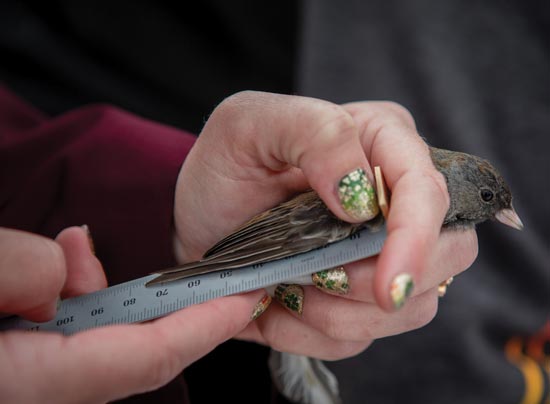Tracking Bird Populations
Next time you hear birds chirping, take some time to appreciate the moment. According to a study in the journal “Science,” birds, chirping or otherwise, have become more rare, with populations dropping over 25% during the past 50 years.
Since fall 2019, Weber State student researchers have been conducting field research to see if bird populations near the Ogden campus have experienced a similar decline.
John Cavitt, professor of zoology, started the research with students by setting up a bird banding station in the foothills east of Stewart Stadium. Using a technique called mark recapture, Cavitt and students captured birds in nets, before placing small numbered bands on their legs and releasing them, hoping to determine populations by the number recaptured over time. The researchers assessed the birds’ physiological condition, looking for signs of illness. Data will be compared to bird population research by former WSU ornithologist Carl Marti to determine if populations are dropping.
 Laura Odland Judd BS ’20, a research participant, said she wasn’t interested in ornithology before taking Cavitt’s ornithology class and conducting research with him on shore birds last summer. Now, her experience benefits her in her role as a veterinarian technician.
Laura Odland Judd BS ’20, a research participant, said she wasn’t interested in ornithology before taking Cavitt’s ornithology class and conducting research with him on shore birds last summer. Now, her experience benefits her in her role as a veterinarian technician.
“Although I haven’t helped yet with an exotic pet, learning how to handle birds during banding will aid me when handling a client’s pet bird,” she said. “My research experience also has helped boost my employment resume and application for veterinarian school.”
Cavitt plans to continue the research to gain more data before publishing results. Along with College of Science Dean Andrea Easter-Pilcher, he also hopes to lead students on a trip to conduct related research at Lake Baikal in Russia’s Siberia region. Originally scheduled for May, the trip was postponed to help prevent the spread of COVID-19.
“We already have compared our current research to research done by Marti in 1977 and have seen a decline in abundance of bird species,” Odland Judd said. “I think this will be a fun project to follow and hopefully bring more attention to bird populations and abundance.”
